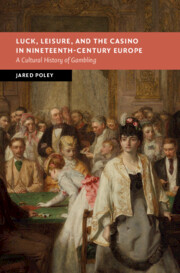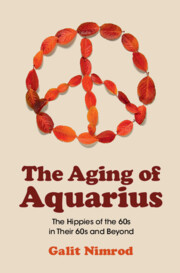89 results
7 - Sexuality and Consumerism in the Modern World: The Business of Pleasure
-
-
- Book:
- The Cambridge World History of Sexualities
- Published online:
- 26 April 2024
- Print publication:
- 16 May 2024, pp 136-158
-
- Chapter
- Export citation
Marx on Leisure: An Aristotelian Interpretation
-
- Journal:
- Canadian Journal of Political Science/Revue canadienne de science politique , First View
- Published online by Cambridge University Press:
- 13 May 2024, pp. 1-19
-
- Article
-
- You have access
- Open access
- HTML
- Export citation
‘The boots will be on the coffin!’: multiple meanings of ageing for older people playing walking football
-
- Journal:
- Ageing & Society , First View
- Published online by Cambridge University Press:
- 24 April 2024, pp. 1-18
-
- Article
-
- You have access
- Open access
- HTML
- Export citation
Chapter 2 - Urban Contexts for Popular Culture in an Age of Transformation
-
- Book:
- Popular Culture and the End of Antiquity in Southern Gaul, c. 400–550
- Published online:
- 15 March 2024
- Print publication:
- 28 March 2024, pp 36-72
-
- Chapter
- Export citation
Not Just One Long Vacation: Revisiting the Importance of Lifestyle Planning in the Transition to Retirement
-
- Journal:
- Canadian Journal on Aging / La Revue canadienne du vieillissement , First View
- Published online by Cambridge University Press:
- 01 February 2024, pp. 1-13
-
- Article
- Export citation
‘When There Is a Ban, There Is a Way’: Everyday Gambling and the Nigerian Political Economy, 1977–83
-
- Journal:
- The Journal of African History / Volume 64 / Issue 3 / November 2023
- Published online by Cambridge University Press:
- 12 December 2023, pp. 351-367
- Print publication:
- November 2023
-
- Article
-
- You have access
- Open access
- HTML
- Export citation
Chapter 11 - A Busy Day in Rome: Pliny, Epistles 1.9 Satirized by Horace, Satires 1.9
- from Part V - Pliny Turns Nasty: Satire and the Scoptic Tradition
-
-
- Book:
- Intertextuality in Pliny's <i>Epistles</i>
- Published online:
- 07 September 2023
- Print publication:
- 21 September 2023, pp 219-240
-
- Chapter
- Export citation
13 - Metal as Leisure Space and Tourism Industry Destination
- from Part IV - Metal Activities
-
-
- Book:
- The Cambridge Companion to Metal Music
- Published online:
- 31 August 2023
- Print publication:
- 14 September 2023, pp 175-186
-
- Chapter
- Export citation
The Politics of Time: The Political Origins of Working-Time Regulation
-
- Journal:
- Social Science History / Volume 48 / Issue 1 / Spring 2024
- Published online by Cambridge University Press:
- 31 August 2023, pp. 65-91
- Print publication:
- Spring 2024
-
- Article
- Export citation

Luck, Leisure, and the Casino in Nineteenth-Century Europe
- A Cultural History of Gambling
-
- Published online:
- 24 August 2023
- Print publication:
- 07 September 2023
Negotiating Experiences of Belonging Alongside Age-Related Life Transitions
-
- Journal:
- Canadian Journal on Aging / La Revue canadienne du vieillissement / Volume 42 / Issue 4 / December 2023
- Published online by Cambridge University Press:
- 31 July 2023, pp. 668-677
-
- Article
-
- You have access
- Open access
- HTML
- Export citation
Reported time allocation and emotional exhaustion during COVID-19 pandemic lockdown in Slovenia
-
- Journal:
- The Economic and Labour Relations Review / Volume 33 / Issue 1 / March 2022
- Published online by Cambridge University Press:
- 01 January 2023, pp. 117-137
-
- Article
-
- You have access
- Open access
- HTML
- Export citation
Chapter 6 - Sex, Drugs, and Rock-n-Roll?
-
- Book:
- The Aging of Aquarius
- Published online:
- 15 December 2022
- Print publication:
- 22 December 2022, pp 126-155
-
- Chapter
- Export citation

The Aging of Aquarius
- The Hippies of the 60s in Their 60s and Beyond
-
- Published online:
- 15 December 2022
- Print publication:
- 22 December 2022
Chapter 11 - Exclusion from Socially Valued Activities
- from Section 2 - Participation of People with Mental Health Conditions
-
- Book:
- Social Inclusion and Mental Health
- Published online:
- 24 November 2022
- Print publication:
- 08 December 2022, pp 227-248
-
- Chapter
- Export citation
Touring Africa - A History of Tourism in Africa: Exoticization, Exploitation, and Enrichment By Todd Cleveland. Athens: Ohio University Press, 2021. Pp. 216. $29.95, paperback (ISBN: 9780821447253); e-book (ISBN: 9780821447253).
-
- Journal:
- The Journal of African History / Volume 63 / Issue 3 / November 2022
- Published online by Cambridge University Press:
- 24 October 2022, pp. 442-443
- Print publication:
- November 2022
-
- Article
- Export citation
Pleasures of the Nollywood Familiar and Everyday Life
-
- Journal:
- African Studies Review / Volume 65 / Issue 4 / December 2022
- Published online by Cambridge University Press:
- 14 October 2022, pp. 810-826
-
- Article
-
- You have access
- Open access
- HTML
- Export citation
“Awa ndi macheza aamai (This is women’s play)”: Examining Pleasure in Urban Malawian Women’s Social Spaces
-
- Journal:
- African Studies Review / Volume 65 / Issue 4 / December 2022
- Published online by Cambridge University Press:
- 14 October 2022, pp. 847-862
-
- Article
- Export citation
Epilogue
-
- Book:
- Why Boredom Matters
- Published online:
- 21 July 2022
- Print publication:
- 04 August 2022, pp 126-134
-
- Chapter
- Export citation
6 - Cultivating Leisure
-
- Book:
- Why Boredom Matters
- Published online:
- 21 July 2022
- Print publication:
- 04 August 2022, pp 109-125
-
- Chapter
- Export citation



